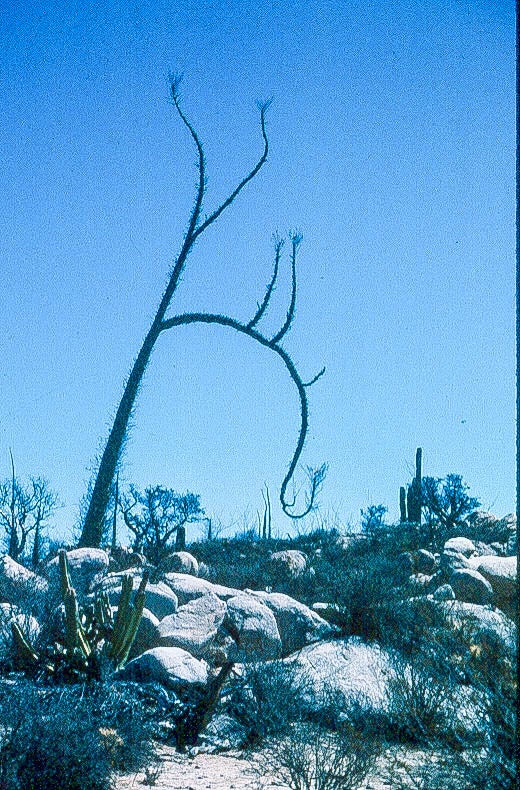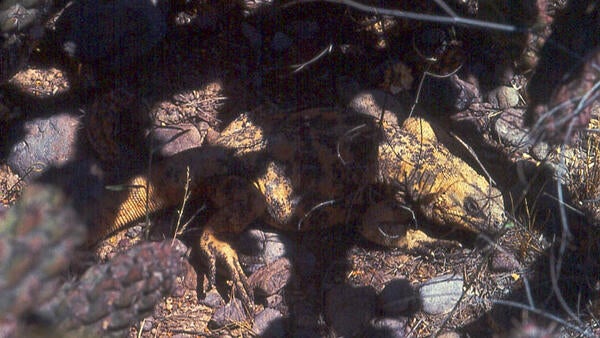Plants and animals along the Gulf of California
“The desert tells a different story every time one ventures on it.” — Robert Edison Fulton Jr.
By DR. CAMERON BARROWS
The southern backdrop of the Coachella Valley, the Santa Rosa and San Jacinto Mountains forms the northern edge of Baja California. While the political boundary with Mexico is still 70-80 miles further south, depending on whether one measures from La Quinta or Palms Springs, the ecological boundary is nevertheless the northern edge of the Peninsular Mountain Range.
One of the iconic plant species of Baja California is the elephant tree, Bursera microphylla. It occurs from the southern tip of Baja to the Santa Rosa Mountains, with its northern-most population in Martinez Canyon. Desert fan palms that seem so much a part of the Coachella Valley landscape have the majority of their range in Baja California. Banded rock lizards, granite spiny lizards, leaf-toed geckos, and Baja collared lizards all are Baja California species that reach their northern-most extent at the edge of the Coachella Valley. All are rock-loving species. Curiously, a tiny population of the leaf-toed gecko has recently been found near the mouth of Long Canyon on the north side of the valley. No one knows for sure how they got across the sand dunes (I have a hunch). Just a bit south, in the Anza Borrego Desert State Park, one can find barefoot banded geckos, black-tailed brush lizards, and Baja California night lizards. Again, all rock-loving species with the bulk of their ranges within Baja California, each reaching their northern limits in the State Park.
During the Pleistocene ice ages, when the Mojave and Colorado Deserts were much colder and wetter and so not so desert-like, Baja California was a refuge for desert-adapted animals and plants, as well as an incubator for new species, some of which shifted north following that last glacial maximum. As you travel south, crossing the international border, the landscape and the species populating that landscape are at first familiar, with all the species we know and see in and around the Coachella Valley. Even “our” peninsular bighorn sheep can be seen along the rock crags as far as at least 1/3 of the way down the peninsula. Keep heading south and new species begin to appear. Blue palms join desert fan palms in the east-facing canyons of the Sierra Juarez and Sierra San Pedro Martir Mountains, like our Santa Rosa and San Jacinto Mountains, they too are part of the Peninsular Mountain Range.
Another elephant tree, Bursera hindsiana, shows up on the alluvial fans. Still further south and you will see a plant seemingly conceived out of a Dr. Seuss story. They look like upside down green carrots, sometimes branching sometimes straight spires reaching heights of 50 feet tall. The first naturalist to see these plants called them Boojums, a reference to the Lewis Carroll fantasy, “The Hunting of the Snark." The story, or rather the poem, describes an epic journey to the edge of the earth, and upon reaching that edge the wanderers spied a plant that grew only there, and christened it a Boojum. Those early naturalists, clearly versed in classic literature, must have been struck by the plant’s odd shape and enormous size and must have felt that they too had reached the edge of the earth. Local Baja Californians call them Cirios, and scientists call them Fouquieria columnaris, the same genus as our ocotillos, but a nearly a hundred times larger. Joining the boojums and elephant trees is an enormous columnar cactus called a cardon. Similar to a saguaro in shape and branching, but much larger. By the time you near the Cape Region almost nothing is familiar, almost, but there are some old friends. Creosote bushes, zebra-tailed lizards, and side-blotched lizards occur all the way down to the tip of the Cape. Chuckwallas and desert iguanas make it almost that far. The Cape Region, despite its familiar species and abundant cactus diversity is classified not as a desert, but as a sub-tropical scrub. Why that would block chuckwallas and desert iguanas is not clear.
At 775 miles in length, Baja California is the longest peninsula in the western hemisphere. It is separated from the mainland of Mexico by the Gulf of California, created by a fault zone running down the center of the Gulf. It is believed that the Cape Region separately sheared off the Mexican mainland and “rafted” to and attached itself to the Peninsula. As a result, there are lizards in the Cape region, such as a spiny-tailed iguana (Ctenosaura hemilopha), and two spiny lizards (Sceloporus spp.) on off shore islands that are more closely related to lizards on the Mexican mainland near Puerta Vallarta.
As interesting as the plants and animals of the peninsula are, what has captured my interest is the life on the islands in the Gulf of California. There are 37 major islands and some 900 small ones and each one seemingly has a different collection of species, and many with described species found nowhere else on earth. All of them as a whole were protected as an "Area Reserve and Migratory Bird Refuge and Wildlife" in 1978. In 2000, the islands were designated a flora and fauna protection area. In addition to this effort by the Mexican government, for its importance and recognition worldwide, all islands in the gulf are also designated as a part of the international program "Man and Biosphere" (MAB) and are part of the World Reserve Network UNESCO Biosphere as Special Biosphere Reserve. This level is well deserved however, it does make accessing exploring the islands challenging. Challenging, but not impossible as long as one hires a local guide who knows and follows the rules.
I have several “favorite” islands. One is Isla Santa Catalina (same name as the island off the southern California Coast, but a very different place). On this island every lizard is endemic, found nowhere else. There are species of desert iguana, chuckwalla, side-blotched lizard, desert spiny lizard, and a whiptail, all only occurring on this island. There is also a barrel cactus there that is almost the size of a saguaro cactus. Not too far away, on one of the largest islands, Isla Espiritu Santo just off the Baja coast from La Paz, has at least six lizard species, but each also occurs on the peninsula, none are endemic. Why the difference? It turns out the channel between the peninsula and Isla Catalina is very deep, whereas the channel between Isla Espiritu Santo and La Paz is relatively shallow. During the last ice age when so much of the Earth’s water was frozen, sea levels were much lower. Isla Espiritu Santo was connected to the peninsula, whereas Isla Santa Catalina was not. Isla Santa Catalina’s long isolation provided the time necessary to develop its own unique species.
Further north in the Gulf there are a couple of additional “deep water” islands that I would include as my favorites. One is a very small island, Isla San Pedro Martir. There are just two lizard species there, both endemic, found nowhere else. One is a side-blotched lizard and the other a whiptail. There is a “forest” of cardon cactus near the top of the island, otherwise it is mostly just a pile of rocks. The other important note is that for just a couple months of the year this is an important nesting site for blue-footed and brown boobies, fish-eating seabirds. I visited this island in the early 1990s, but I suspect such a visit would be much more difficult today, being both a protected sea bird nesting site and a Man and Biosphere Reserve. We were there at the height of the nesting season and every flat spot had a nest with chicks. To move around I had to step over the nests. The adults’ attachment to their chicks was so strong that none took flight or pecked at me, they just carefully watched every move I made. My interest was with the side-blotched lizards, Uta palmeri; they were nearly the size of an adult desert spiny lizard. That big, yet the island was nearly devoid of vegetation, and so devoid of most insects. What did the side-blotched lizards eat and why were they so big? It turns out they eat fish scraps left over when the boobies feed their young, along with flies also attracted to the scraps. So, for a couple months the boobies provide an unending banquet. The rest of the year the lizards have little if anything to eat. Being big ectotherms, the lizards do not need to spend much calories on basic day to day metabolism, but they still need to stay alive. It turns out that the bigger they are the more muscle and fat they can store and then live off of for the 9-10 months of the year the boobies are not there. If they were a mammal, an endotherm burning lots of calories each day just to stay alive, they would certainly starve.
My other favorite island is Isla San Esteban. San Esteban is a middle-sized island with plenty of vegetation to eat. With plenty to eat, the island has its own species of chuckwalla, Sauromalus varius. Like the Isla San Pedro Martir side-blotched lizards, these chuckwallas are bigger than their mainland counterparts. In this case about 30” long (compared to a mainland 15-20”) and about three pounds (compared to a mainland 1-2 pounds). So almost the size of a dachshund. One of the San Esteban chuckwalla’s favorite foods are cactus fruits. I examined all the chuckwalla scat I could find and they were all filled with cactus spines. With all the other plants available, the chuckwallas preferred cactus fruits. I still squirm when I think of those spines making all the way through, down their throat, esophagus, through their stomach, intestines and out the other end. Why do the chuckwallas get so big? I suspect it is a similar story to that of the San Pedro Martir side-blotched lizards, temporary high calorie food abundance, followed by fasting.
If those hypotheses are correct, and there is a survival advantage to being bigger, it begs the question of why don’t the mainland desert lizards get bigger? Or those side-blotched and chuckwalla lizards on Isla Santa Catalina? Naturalists have long pondered this question. On islands around the world, endemic species can sometimes be significantly larger or smaller than their mainland counterparts. On Santa Cruz and Santa Rosa islands of the coast from Santa Barbara there once was a miniature wholly mammoth, maybe the size of a Shetland pony. During the last glacial maximum these two islands were connected, but even still there would not have been sufficient food to keep a population of those giant mainland endothermic mammoths alive. Being smaller allowed them to survive. One key to the ectothermic gigantism of some of the lizards occupying the islands in the Gulf of California seems to be a dependence on high calorie foods that are only available for a short time of the year. The more southerly islands, which lack gigantic lizards, are in a more tropical climate, and lack the strong seasonality of the drier, more northern islands. That seasonality leads lizards to adapt to a feast then famine food supply.
Nullius in verba
Go outside, tip your hat to a chuckwalla (and a cactus), think like a mountain, and be safe.

